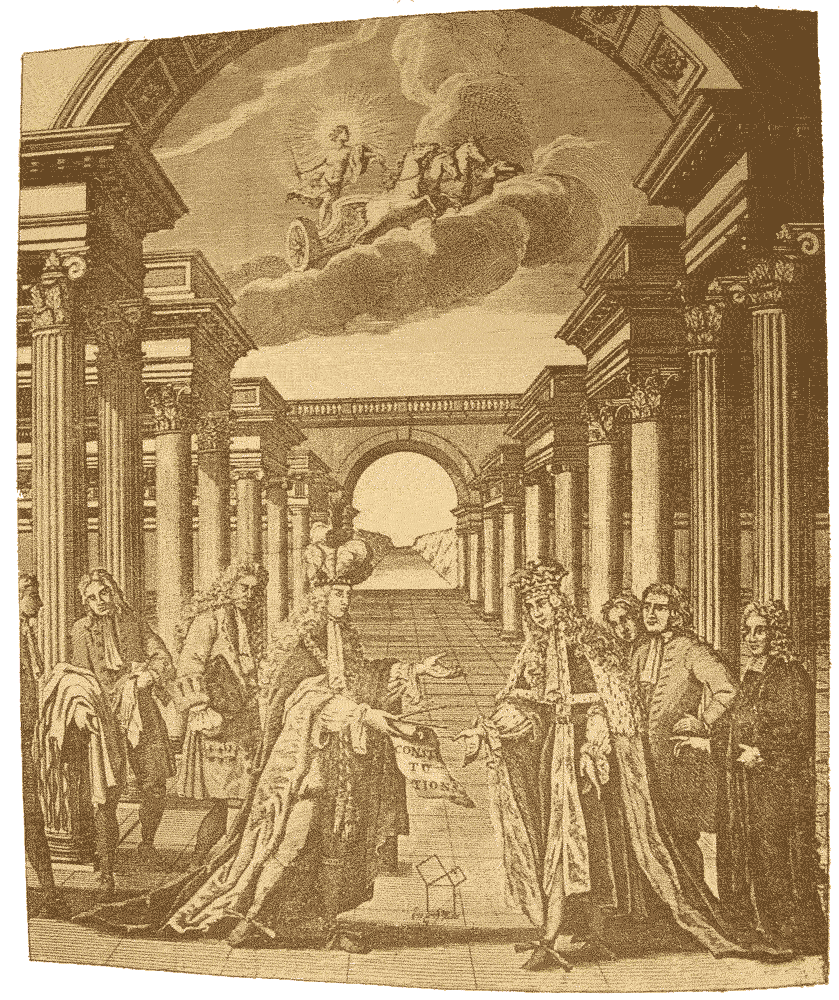Clarendon Lodge n° 8023Wolverhampton - EnglandProvince of Staffordshire | ||
| Photograph of the Frontispiece of the original manuscript of James Anderson’s new Constitutions issued in 1727. | ||
|
JAMES ANDERSON was born, bred and highly educated in Aberdeen, Scotland, where Aberdeen University granted him a Doctor of Divinity degree as late as 1731. His father was, several times, Master and Secretary of the Lodge of Aberdeen within which only a fifth of the members were stonemasons. |
 |
JAMES ANDERSON grew up in a ‘Masonic’ household. He is likely also to have been initiated in Scotland before he travelled to London.
|
|
| ||
|
On the left is the 5th Grand Master, the Duke of Montagu, in his robes of the Garter. He is handing a pair of compasses and a document to the Duke of Wharton, his successor as Grand Master in 1722. The compasses, the only ‘tools’ depicted in the frontispiece, are said to belong to the Grand Master. Each of the two Grand Masters is accompanied by his Officers: The Duke of Montagu is flanked by Dr John Beal the Deputy Grand Master, Josias Villeneau his Senior Warden, who holds a group of aprons and gloves and Thomas Morris, the Junior Warden. Behind the Duke of Warthon stand his Deputy Dr. John Theophilus Desaguliers, in his clergy dress, and the two Wardens; Joshua Timson and William Hawkins. Centrally placed on the floor, between the two Grand Master, is the diagram of the forty-seventh proposition of Euclid beneath which the word Eureka is written out in Greek script. Anderson refers to the formula on page 20 of the Constitutions when, with regard to Geometry, he states: . . . the Greater Pythagoras, prov’d the Author of the 47th Proposition of Euclid’s first Book, which, if duly observ’d, is the Foundation of all Masonry, sacred, civil, and military. Clearly Anderson chose Euclid’s theorem, attributed to Pythagoras (that in a right angled triangle the square of the hypotenuse is equal to the sum of the squares of the other two sides) because of it symbolises Geometry, traditionally, the most important of the Liberal Arts and Sciences. The Greek word Eureka, however, under the emblem has been interpreted in two ways: A) as a possible error. The engraver of the frontis piece, John Pine or maybe Anderson himself, may have confused Archimedes' famed outcry with the Pythagorean theory; B) It may have been intentional. ‘Eureka’, which literally translates from the Greek as ‘I have found’, was first used by Archimedes. There is no reason, however – at a time when Greek was a popular language in Europe – for the word to be applied to other major achievements. Thus the association of the word Eureka with the emblem of a most important discovery, the 47th proposition, may well have been intentional. | ||
|
© Copyright 2011-2017 Clarendon Lodge N° 8023 | ||